with复合结构和独立主格结构
独立主格与with复合结构汇总

I. 独立主格结构的基本概念由一个名词或代词作为逻辑主语,加上一个分词、形容词、副词、动词不定式或介词短语作为逻辑谓语构成,这种结构在形式上与主句没有关系,通常被称为独立主格结构。
独立主格结构是由一个相当于主语的名词或代词加上非谓语动词、形容词(副)词、或介词短语构成的一种独立成分。
该结构不是句子,也不是从句,所以它内部的动词不能考虑其时态、人称和数的变化,它与其主句之间既不能通过并列连词连接也不能有从句引导词引导,常用逗号与其主句隔开。
独立主格结构主要起状语作用,相当于一个状语从句,多用来表示行为、方式、伴随等情况,有时也可用来表示时一、独立主格结构的构成形式1、逻辑主语+V-ing : 逻辑主语是分词的动作执行者。
如:Time permitting, we can have a walk around the playground after supper.①.______no bus, we had to walk home. A. There being B. Being C. Having been D. There was②._______no bus, we had to walk home. A. As there being B. As there was C. Being D. There was③._______Sunday, the library doesn't open. A. Being B. There being C. It being D. Having been④.______Sunday, the library doesn't open. A. As it being B . Being C. It is D. As it isABCD2、逻辑主语+V-ed 该构成形式内部的逻辑主语是分词的动作承受者。
如:The experiment done, the students went on to take notes in the experiment report.①._____, the train started. A. The signal given B. Giving the signal B. The signal being given D. The signal giving②._____, the train started.A. After having given the signalB. After the signal givenC. Giving the signalD. After the signal was given③._________, the text became easier for us to learn.A. Explaining new wordsB. New words explainedC. Being explained new wordsD. Having explained new words④.______________, the text became easier for us to learn.A. When new words were explainedB. Explaining new words B. New words explaining D. Being explained new words ADBA3、逻辑主语+形容词(副词)该结构相当于一个未带动词的“主—系—表”结构。
with的复合结构和独立主格结构
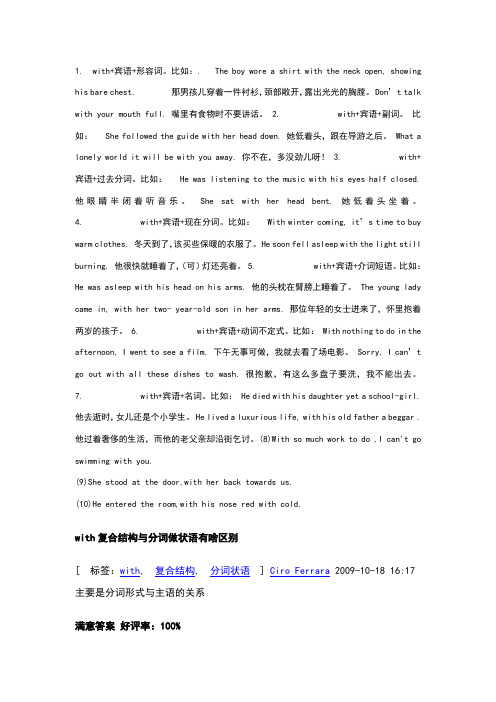
1. with+宾语+形容词。
比如:. The boy wore a shirt with the neck open, showing his bare chest. 那男孩儿穿着一件衬衫,颈部敞开,露出光光的胸膛。
Don’t talk with your mouth full. 嘴里有食物时不要讲话。
2. with+宾语+副词。
比如:She followed the guide with her head down. 她低着头,跟在导游之后。
What a lonely world it will be with you away. 你不在,多没劲儿呀!3. with+宾语+过去分词。
比如:He was listening to the music with his eyes half closed. 他眼睛半闭着听音乐。
She sat with her head bent. 她低着头坐着。
4. with+宾语+现在分词。
比如:With winter coming, it’s time to buy warm clothes. 冬天到了,该买些保暖的衣服了。
He soon fell asleep with the light still burning. 他很快就睡着了,(可)灯还亮着。
5. with+宾语+介词短语。
比如:He was asleep with his head on his arms. 他的头枕在臂膀上睡着了。
The young lady came in, with her two- year-old son in her arms. 那位年轻的女士进来了,怀里抱着两岁的孩子。
6. with+宾语+动词不定式。
比如: With nothing to do in the afternoon, I went to see a film. 下午无事可做,我就去看了场电影。
Sorry, I can’t go out with all these dishes to wash. 很抱歉,有这么多盘子要洗,我不能出去。
中英语with复合结构与独立主格结构讲解

中英语with复合结构与独立主格结构讲解字体大小:大中小晓晓发表于2011-11-07 23:12评论0条阅读497次不少学生对with结构的用法比较复杂,不少英语学习者总感觉不甚清楚,现将一介词with、二with复合结构、三独立主格结构、四动词独立主格结构、五with/without 引导的独立主格结构总结如下。
with结构也称为with复合结构,首先要与介词with的用法区别开来。
先让我们全面了解介词with的用法。
一、介词with的用法with prep.其主要词义包括“有, 以, 用, 同...,由于, 和...一致, 赞成, 关于......” 等21种词义。
1. the company of; accompanying:和,陪伴:在…陪伴下;随同:2.Did you go with her?你跟她一起去吗?Next to; alongside of:在…旁边,同…在一起:stood with the rabbi; sat with the family.与教士站在一起,与家人坐在一块儿3.Having as a possession, an attribute, or a characteristic:带着,带来:作为所有物、属性或特点具有:arrived with bad news; a man with a moustache.带来坏消息;留络腮胡子的男人4.In a manner characterized by:以…方式:performed with skill; spoke with enthusiasm.很有技巧地表演;热情地说话5.In the performance, use, or operation of:使用:在…的表现、使用或运行中:had trouble with the car.汽车出了毛病6.In the charge or keeping of:负责,照料:left the cat with the neighbors.把猫托邻居照顾7.In the opinion or estimation of:以…的观点或估计:if it's all right with you.如果你没异议的话8.In support of; on the side of:支持,赞同:I'm with anyone who wants to help the homeless.我支持任何想帮助流浪汉的人7.Of the same opinion or belief as:和…一致:与…有相同观点或信仰:He is with us on that issue.在那个议题上他和我们观点一致8.By the means or agency of:用:通过…的方式或媒介:eat with a fork; made us laugh with his jokes.用叉子吃饭;以他的笑话引我们发笑9. In spite of:尽管:With all her experience, she could not get a job.尽管很有经验,她还是找不到工作10. In the same direction as:与…同向:sail with the wind; flow with the river.顺风起帆;顺河而流11. At the same time as:与…同时:gets up with the birds.与鸟儿同时起床12. In regard to:关于,对于:We are pleased with her decision. They are disgusted with the situations.她这样决定,我们很高兴;他们对现状很厌恶13. Used as a function word to indicate a party to an action, a communicative activity, or an informal agreement or settlement:和…:用作功能词表示某个动作、交流活动或非正式协议或决定的一方:played with the dog; had a talk with the class; lives with an aunt.与狗玩;和班上的同学谈一谈;与姑母住在一起14. In comparison or contrast to:与…相比;与…对照:a dress identical with the one her sister just bought.和她姐姐刚买衣服同一款式15. Having received:收到,获得:With her permission, he left. I escaped with just a few bruises.获得她允许后,他离开了。
with_结构和独立主格

当表人体部位的词做逻辑主语时,及物动词 用现在分 词,不及物动词用过去分词。 He lay there, his teeth set, his hand clenched, his eyes looking straight up. Weather___, we'll go out for a walk. A permitted B permitting C permits D for permitting
表伴随时,既可用分词的独立结构,也可用with 的复合结构。 with +名词(代词)+现在分词/过去 分词/形容词/副词/不定式/介词短语 举例: He stood there, his hand raised. = He stood there, with his hand raise. The murder was brought in, with his hands ___ behind his back。A. being tied B. having tied C. to be tied D. tied 独立主格结构使用介词的问题: 当介词是in时, 其前后的两个名词均不加任何成分(如物主代词 或冠词),也不用复数。但 with 的复合结构不 受此限制 A robber burst into the room, knife in hand. ( hand前不能加his)。
with结构与独立主格结构的关系
with结构属于独立主格结构,但在结构上, with结构由介词with或without引导,名词前有 冠词、形容词、所有格代词或其它词类所修 饰,结构较松散;而独立主格结构没有with 或without引导,结构严密,名词前可用可不 用修饰语。在句法功能上,with结构可以作 定语,独立主格结构则不能;独立主格结构 通常在句中作状语,但也可以作主语,而 with结构则不能。
with的复合结构和独立主格的异同
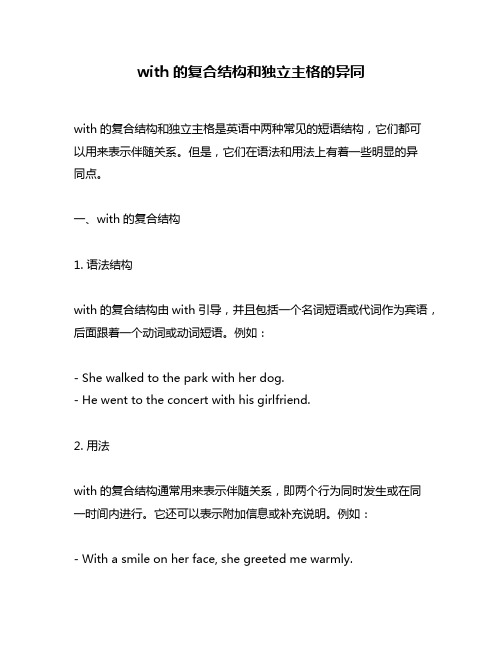
with的复合结构和独立主格的异同with的复合结构和独立主格是英语中两种常见的短语结构,它们都可以用来表示伴随关系。
但是,它们在语法和用法上有着一些明显的异同点。
一、with的复合结构1. 语法结构with的复合结构由with引导,并且包括一个名词短语或代词作为宾语,后面跟着一个动词或动词短语。
例如:- She walked to the park with her dog.- He went to the concert with his girlfriend.2. 用法with的复合结构通常用来表示伴随关系,即两个行为同时发生或在同一时间内进行。
它还可以表示附加信息或补充说明。
例如:- With a smile on her face, she greeted me warmly.- He left the party early with a headache.二、独立主格1. 语法结构独立主格是指一个名词短语或代词加上一个动名词,它们之间没有任何连接词。
例如:- The sun having set, we made our way back home.- Me being sick, I couldn't go to work today.2. 用法独立主格也表示伴随关系,但它更侧重于描述先决条件或原因。
通常情况下,独立主格放在句子的开头,用逗号与主句分开。
例如:- The weather being nice, we decided to have a picnic.- Her parents having died, she was left alone in the world.三、异同点1. 语法结构with的复合结构和独立主格在语法结构上有很大的差别。
前者是一个介词短语加上一个宾语和动词,后者则是一个名词短语或代词加上一个动名词。
2. 用法虽然两种结构都可以表示伴随关系,但是它们在用法上有一些不同。
9-1-with-复合结构和独立主格
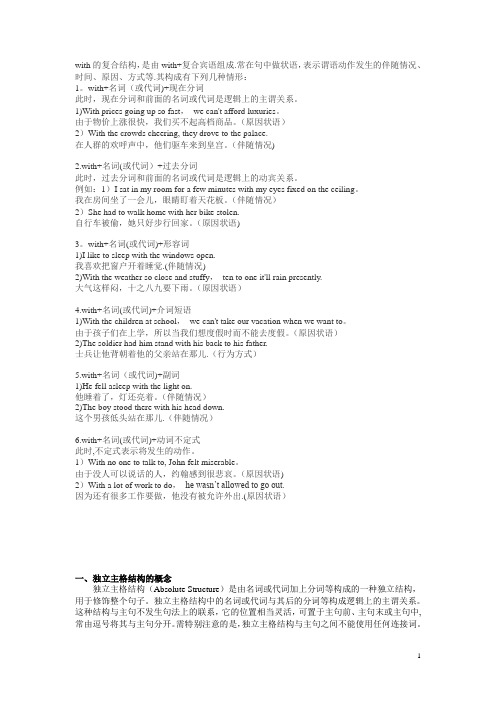
with的复合结构,是由with+复合宾语组成.常在句中做状语,表示谓语动作发生的伴随情况、时间、原因、方式等.其构成有下列几种情形:1。
with+名词(或代词)+现在分词此时,现在分词和前面的名词或代词是逻辑上的主谓关系。
1)With prices going up so fast,we can't afford luxuries。
由于物价上涨很快,我们买不起高档商品。
(原因状语)2)With the crowds cheering, they drove to the palace.在人群的欢呼声中,他们驱车来到皇宫。
(伴随情况)2.with+名词(或代词)+过去分词此时,过去分词和前面的名词或代词是逻辑上的动宾关系。
例如:1)I sat in my room for a few minutes with my eyes fixed on the ceiling。
我在房间坐了一会儿,眼睛盯着天花板。
(伴随情况)2)She had to walk home with her bike stolen.自行车被偷,她只好步行回家。
(原因状语)3。
with+名词(或代词)+形容词1)I like to sleep with the windows open.我喜欢把窗户开着睡觉.(伴随情况)2)With the weather so close and stuffy,ten to one it'll rain presently.大气这样闷,十之八九要下雨。
(原因状语)4.with+名词(或代词)+介词短语1)With the children at school,we can't take our vacation when we want to。
由于孩子们在上学,所以当我们想度假时而不能去度假。
(原因状语)2)The soldier had him stand with his back to his father.士兵让他背朝着他的父亲站在那儿.(行为方式)5.with+名词(或代词)+副词1)He fell asleep with the light on.他睡着了,灯还亮着。
with 的复合结构和独立主格结构

1. with+宾语+形容词。
比如:。
The boy wore a shirt with the neck open, showing his bare chest. 那男孩儿穿着一件衬衫,颈部敞开,露出光光的胸膛. Don't talk with your mouth full。
嘴里有食物时不要讲话.2. with+宾语+副词。
比如: She followed the guide with her head down. 她低着头,跟在导游之后。
What a lonely world it will be with you away. 你不在,多没劲儿呀!3. with+宾语+过去分词。
比如: He was listening to the music with his eyes half closed。
他眼睛半闭着听音乐. She sat with her head bent。
她低着头坐着。
4。
with+宾语+现在分词。
比如:With winter coming, it’s time to buy warm clothes。
冬天到了,该买些保暖的衣服了. He soon fell asleep with the light still burning。
他很快就睡着了,(可)灯还亮着. 5. with+宾语+介词短语。
比如:He was asleep with his head on his arms。
他的头枕在臂膀上睡着了。
The young lady came in, with her two- year—old son in her arms. 那位年轻的女士进来了,怀里抱着两岁的孩子。
6。
with+宾语+动词不定式。
比如:With nothing to do in the afternoon, I went to see a film。
下午无事可做,我就去看了场电影。
Sorry, I can’t go out with all these dishes to wash。
with复合短语和独立主格结构的区别

一、 with结构的构成它是由介词with或without+复合结构构成,复合结构作介词with或without的复合宾语,复合宾语中第一部分宾语由名词或代词充当,第二部分补足语由形容词、副词、介词短语、动词不定式或分词充当,分词可以是现在分词,也可以是过去分词。
With结构构成方式如下:1. with或without-名词/代词+形容词;2. with或without-名词/代词+副词;3. with或without-名词/代词+介词短语;4. with或without-名词/代词 +动词不定式;5. with或without-名词/代词 +分词。
下面分别举例:1、 She came into the room,with her nose red.(with+名词+形容词,作伴随状语)2、 With the meal over , we all went home.(with+名词+副词,作时间状语)3、The master was walking up and down with the ruler under his arm。
(with+名词+介词短语,作伴随状语。
) The teacher entered the classroom with a book in his hand.4、He lay in the dark empty house,without a man ,woman or child to say he was kind to me.(with+名词+不定式,作伴随状语) He could not finish it without me to help him.(without+代词 +不定式,作条件状语)5、She fell asleep with the light burning.(with+名词+现在分词,作伴随状语)6. Without anything left in the cupboard, she went out to get something to eat.(without+代词+过去分词,作为原因状语)二、with结构的用法在句子中with结构多数充当状语,表示行为方式,伴随情况、时间、原因或条件(详见上述例句)。
英语高考独立主格及with复合结构
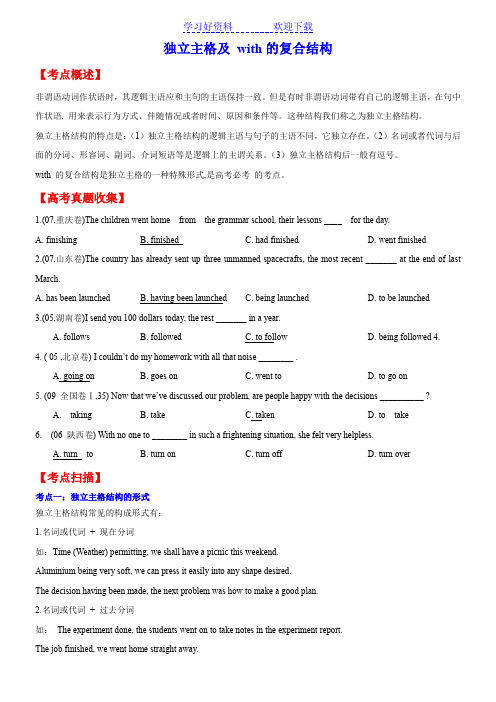
独立主格及with的复合结构【考点概述】非谓语动词作状语时,其逻辑主语应和主句的主语保持一致。
但是有时非谓语动词带有自己的逻辑主语,在句中作状语, 用来表示行为方式、伴随情况或者时间、原因和条件等。
这种结构我们称之为独立主格结构。
独立主格结构的特点是:(1)独立主格结构的逻辑主语与句子的主语不同,它独立存在。
(2)名词或者代词与后面的分词、形容词、副词、介词短语等是逻辑上的主谓关系。
(3)独立主格结构后一般有逗号。
with 的复合结构是独立主格的一种特殊形式,是高考必考的考点。
【高考真题收集】1.(07,重庆卷)The children went home from the grammar school, their lessons ____ for the day.A. finishingB. finishedC. had finishedD. went finished2.(07,山东卷)The country has already sent up three unmanned spacecrafts, the most recent _______ at the end of last March.A. has been launchedB. having been launchedC. being launchedD. to be launched3.(05,湖南卷)I send you 100 dollars today, the rest _______ in a year.A. followsB. followedC. to followD. being followed 4.4. ( 05 ,北京卷) I couldn’t do my homework with all that noise ________ .A. going onB. goes onC. went toD. to go on5. (09 全国卷Ⅰ,35) Now that we’ve discussed our problem, are people happy with the decisions __________ ?A. takingB. takeC. takenD. to take6. (06 陕西卷) With no one to ________ in such a frightening situation, she felt very helpless.A. turn toB. turn onC. turn offD. turn over【考点扫描】考点一:独立主格结构的形式独立主格结构常见的构成形式有:1.名词或代词+ 现在分词如:Time (Weather) permitting, we shall have a picnic this weekend.Aluminium being very soft, we can press it easily into any shape desired.The decision having been made, the next problem was how to make a good plan.2.名词或代词+ 过去分词如:The experiment done, the students went on to take notes in the experiment report.The job finished, we went home straight away.The sum added, we’ll have enough money for the trip.注意:用现在分词还是过去分词,要看前面的名词或代词与后面动词的关系。
2023届高考英语语法专题之with复合结构及独立主格结构课件

• Conditions__p_e_r_m__itting (permit), we’ll go sightseeing in Gaopo.
• The exam __t_o__b_e_ held (hold) tomorrow, I couldn’t go to the cinema tonight.
Time permitting, I will love him forever. 如果时间允许的话,我会永远爱他.
=If time permits
___W___e_a_t_h__e_r_p__e_r_m__i_t_t_i(ng天 气 允 许 ), they will start at six tomorrow morning.
Two twin babies are sleeping together, no clothes_w__o_r_n___(没穿 衣服) (wear)
_A__l_o_t__o_f__h_o_m___e_w__o_r_k__to do(有很多作 业要做), the girl goes to bed very late every night.
With his dream realized, the man felt extremely happy.
=After his dream had realized
_W__i_t_h__w__i_n_t_e_r__c_o_m___in_(g冬o天n来了), the trees turn yellow and some birds fly south. (with)
1独立主格结构和with复合结构复习[课件]
![1独立主格结构和with复合结构复习[课件]](https://img.taocdn.com/s3/m/c4530e55df80d4d8d15abe23482fb4daa58d1d0b.png)
the post office .
5. ________to the left , and you'll find
the post office .
• A. Turning B. To turn C. Turn D. Turned
• 二、分析逻辑主语 确定要选非谓语动词之后,第二步要分析其逻 辑主语。非谓语动词虽不能作谓语,但仍具有 动词特点,其逻辑上的动作执行者就叫做逻辑 主语。非谓语动词作状语时,其逻辑主语须和 句子的真正主语一致。若不一致,则须加上自 己的逻辑主语。 1. ________no buses , we have to walk home .
=Here are the first three volumes and the fourth one is coming out next month.
(Ⅱ) with和without复合结构可以作 后置定语修饰名词,而独立主格结
构则不可作后置定语修饰名词。
Soon she arrived at a park with grass green and flowers in blossom.
1. ______from space , the earth looks blue .
2.______from space , we can see the earth is blue .
• A. Seen B. Seeing C. To see D.See 3. The dirty clothes ______ , the girl hung them up outside . 4. _____ the dirty clothes ,the girl hung them up outside .
高考英语语法复习——独立主格及with的复合结构

•
4. ( 05 ,北京卷) I couldn ’ t do my homework with all that noise ________ .Βιβλιοθήκη •• • • • •
A. going on B. goes on C. went to D. to go on
5. (09 全国卷Ⅰ,35) Now that we’ve discussed our problem, are people happy with the decisions __________ ? A. taking B. take C. taken D. to take 6. (06 陕西卷) With no one to ________ in such a frightening situation, she felt very helpless. A. turn to B. turn on C. turn off D. turn over Key: 1. B 2. B 3. C 4. A 5. C 6. A
The decision having been made, the next problem was how to make a good plan. 2.名词或代词 + 过去分词
•
•
如: The experiment done, the students went on to take notes in the experiment report.
【考点训练】
• 一、单项填空
•
• •
1. (09 成都第二次诊断性检测,3) ______ time going on, what he said proved true.
A. As B. For C. With D. Through 2. (09 桂林调研卷,32) With a lot of tough problems ______ , the manager was as nervous as a cat on hot bricks.
7.精品-独立主格结构和with的复合结构
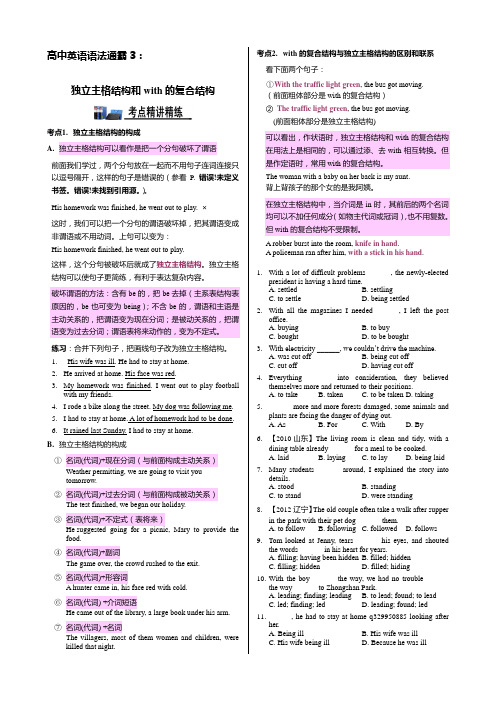
高中英语语法通霸3:独立主格结构和with的复合结构考点1.独立主格结构的构成A.独立主格结构可以看作是把一个分句破坏了谓语前面我们学过,两个分句放在一起而不用句子连词连接只以逗号隔开,这样的句子是错误的(参看P. 错误!未定义书签。
错误!未找到引用源。
)。
His homework was finished, he went out to play.×这时,我们可以把一个分句的谓语破坏掉,把其谓语变成非谓语或不用动词。
上句可以变为:His homework finished, he went out to play.这样,这个分句被破坏后就成了独立主格结构。
独立主格结构可以使句子更简练,有利于表达复杂内容。
破坏谓语的方法:含有be的,把be去掉(主系表结构表原因的,be也可变为being);不含be的,谓语和主语是主动关系的,把谓语变为现在分词;是被动关系的,把谓语变为过去分词;谓语表将来动作的,变为不定式。
练习:合并下列句子,把画线句子改为独立主格结构。
1.His wife was ill. He had to stay at home.2.He arrived at home. His face was red.3.My homework was finished. I went out to play footballwith my friends.4.I rode a bike along the street. My dog was following me.5.I had to stay at home. A lot of homework had to be done.6.It rained last Sunday. I had to stay at home.B.独立主格结构的构成①名词(代词)+现在分词(与前面构成主动关系)Weather permitting, we are going to visit youtomorrow.②名词(代词)+过去分词(与前面构成被动关系)The test finished, we began our holiday.③名词(代词)+不定式(表将来)He suggested going for a picnic, Mary to provide the food.④名词(代词)+副词The game over, the crowd rushed to the exit.⑤名词(代词)+形容词A hunter came in, his face red with cold.⑥名词(代词) +介词短语He came out of the library, a large book under his arm.⑦名词(代词) +名词The villagers, most of them women and children, were killed that night.考点2.with的复合结构与独立主格结构的区别和联系看下面两个句子:①W ith the traffic light green, the bus got moving.(前面粗体部分是with的复合结构)②The traffic light green, the bus got moving.(前面粗体部分是独立主格结构)可以看出,作状语时,独立主格结构和with的复合结构在用法上是相同的,可以通过添、去with相互转换。
独立主格结构和with复合结构

巩固练习
1.______ no bus, we had to walk home. A. There was B. There being C. Because there being D. There were 2. _____, we all went home happily. A. Goodbye was said B. Goodbye had been said C. Goodbye said D. When goodbye said 3____, the hunter went into the forest. A. A gun on shoulder B. A gun was on his shoulder C. Gun on shoulder D. A gun being on shoulder
(Ⅴ)名词/代词+介词短语 在这一结构中,如果逻辑主语与介词短语 中的名词都是单数名词,这些名词前习惯 不用冠词。
1.Our teacher came into the classroom, book in hand. 2.Flag on shoulder, the soldier rushed to the top of the mountain.
(2)作原因状语
With the key lost, she could not enter the room. =The key lost, she could not enter the room. =As/Because the key had been lost, she could not enter the room.
(Ⅰ) with和without复合结构与独立主格结构在句 中作状语时,一般可相互转换;此外还可变为状语从 句或并列句。 (1)作时间状语 With winter coming on, the trees turn yellow and some birds fly south. =Winter coming on, the trees turn yellow and some birds fly south. = When winter comes on, the trees turn yellow and some birds fly south.
with的复合结构和独立主格结构.docx
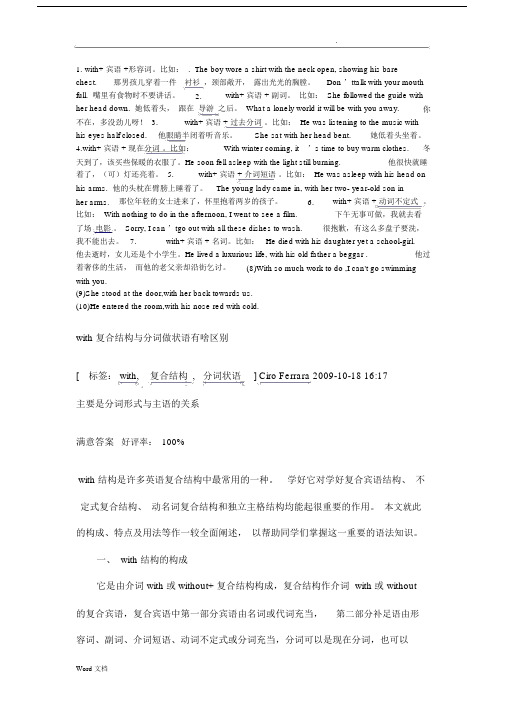
.1. with+ 宾语 +形容词。
比如: . The boy wore a shirt with the neck open, showing his barechest.那男孩儿穿着一件衬衫,颈部敞开,露出光光的胸膛。
Don ’ttalk with your mouth full. 嘴里有食物时不要讲话。
2.with+ 宾语 + 副词。
比如: She followed the guide with her head down. 她低着头,跟在导游之后。
What a lonely world it will be with you away.你不在,多没劲儿呀! 3.with+ 宾语 + 过去分词。
比如: He was listening to the music with his eyes half closed.他眼睛半闭着听音乐。
She sat with her head bent.她低着头坐着。
4.with+ 宾语 + 现在分词。
比如:With winter coming, it’s time to buy warm clothes.冬天到了,该买些保暖的衣服了。
He soon fell asleep with the light still burning.他很快就睡着了,(可)灯还亮着。
5.with+ 宾语 + 介词短语。
比如: He was asleep with his head on his arms. 他的头枕在臂膀上睡着了。
The young lady came in, with her two- year-old son inher arms.那位年轻的女士进来了,怀里抱着两岁的孩子。
6.with+ 宾语 + 动词不定式。
比如: With nothing to do in the afternoon, I went to see a film.下午无事可做,我就去看了场电影。
独立主格结构和with复合结构

Withr a walk.
由于没有什么事情可做,他便到外面散步去了。
2. with+名词(代词)+形容词/副词/介词短语
The meeting over(=After themeetingwasover), they all went home.会议一结束,他们就都回家了。
Two hundred people died in the accident, many of them children(=andmany of themwerechildren).
两百人死于事故,其中有许多儿童。
The boywentto the classroom,book in hand(=and a book was in his hand).那男孩手里拿着书去教室。
二.with复合结构
with复合结构也是一种独立主格结构,用法同独立主格结构。主要有以下两种情况:
1.with+名词(代词)+分词/不定式
He fell asleep with the windows open.他开着窗睡觉。
He came into the room,withhisdog out.他回到了房子里,他的狗在外面。
He came out of the library,witha large book under hisarm.他夹着本厚书,走出了图书馆。
独立主格结构和with复合结构
一.独立主格结构
独立主格结构是由名词或代词加上非谓语动词、形容词、副词、名词、介词短语等构成的一种独立结构,用来修饰整个句子。这种结构与主句不发生句法上的联系,它的位置相当灵活,可置于主句前、主句末或主句中,常由逗号将其与主句分开。需特别注意的是,独立主格结构与主句之间不能使用任何连接词,如果有并列连词或从属连词,则用完整的谓语动词形式。
With复合结构与独立主格结构

一:With复合结构与独立主格结构with复合结构与独立主格结构是英语中常见的两种结构形式。
从某种意义上说,它们可以算作是非谓语动词用法的延伸。
它们都可以在句中作原因状语、伴随状况状语、条件状语、时间状语或结果状语用,一般也可以相互转换。
虽然它们的语法功能和意义相同,但其结构形式和名称却不相同。
抓住这一点,就可以把二者融会贯通,从而在阅读中减少不必要的理解障碍。
with复合结构的模式是:with+名词/代词(作逻辑主语)+分词/形容词/副词/不定式/介词短语(作逻辑谓语)独立主格结构的模式是:主格名词/代词(作逻辑主语)+分词/形容词/副词/不定式/介词短语(作逻辑谓语)请看下例:一、作时间状语1、With winter coming on, the trees turn yellow and some birds fly south.=Winter coming on, the trees turn yellow and some birds fly south.2、With our work having been finished well, we went out for a holiday.=Our work having been finished well, we went out for a holiday. 3、With the traffic light green, the bus got moving.=The traffic light green, the bus got moving.4、With the wedding dinner party(being) over, we left the hotel.=The wedding dinner party(being) over, we left the hotel.二、作原因状语5、With it being Sunday, the library was closed.=It being Sunday, the library was closed.6、With the weather terribly cold, we entered the room to warm ourselves.=The weather terribly cold, we entered the room to warm ourselves. 7、With us to care for the children you are able to be carefree away from home.=We to care for the children, you are able to be carefree away from home.(注意此处的we 不得改成us,用了us便不是独立主格结构了。
独立主格结构与with复合结构

练手吧!
1. Darkness ______ in, the young people strolled on the streets. A. set B. setting C. has set D. was set 2. The production ______ steadily, the factory needs an everincreasing supply of raw material (原料). A. has gone up B. is going up C. having gone up D. being gone up 3. Father came home, _________. A. a dog following him B. a dog followed him C. being followed by a dog D. all the above 4.She stood there, _____ from her cheeks. A. tears' rolling down B. tears rolled down C. with tears rolled down D. tears rolling down
名词/主格代词+形容词
1)这么多人缺席,会议不得不取消。
So many people (being)absent, the meeting had to be called off.
2)那架飞机遭遇了空难,无一人生还。
An air accident happened to the plane, nobody(being) alive.
不同:with复合结构常用于日常生活中, 更口语化。而独立主格结构则多用于描绘 文字,即多用于文学中,使之所描绘的内 容更加生动有色
with 的复合结构和独立主格
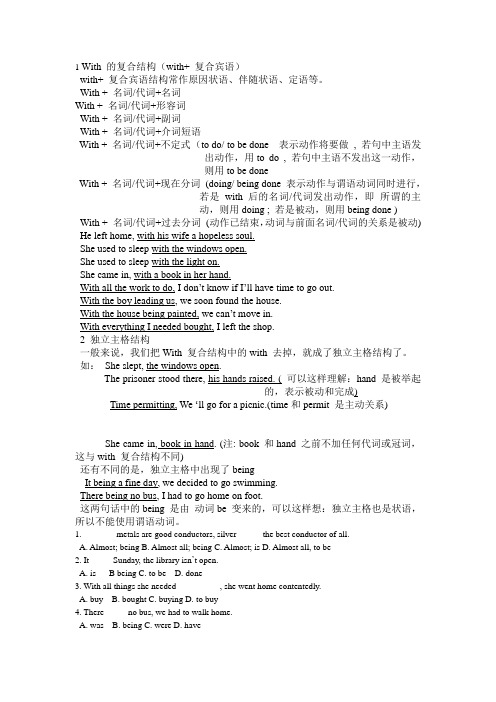
1 With 的复合结构(with+ 复合宾语)with+ 复合宾语结构常作原因状语、伴随状语、定语等。
With + 名词/代词+名词With + 名词/代词+形容词With + 名词/代词+副词With + 名词/代词+介词短语With + 名词/代词+不定式(to do/ to be done 表示动作将要做, 若句中主语发出动作,用to do , 若句中主语不发出这一动作,则用to be doneWith + 名词/代词+现在分词(doing/ being done 表示动作与谓语动词同时进行,若是with 后的名词/代词发出动作,即所谓的主动,则用doing ; 若是被动,则用being done )With + 名词/代词+过去分词(动作已结束,动词与前面名词/代词的关系是被动) He left home, with his wife a hopeless soul.She used to sleep with the windows open.She used to sleep with the light on.She came in, with a book in her hand.With all the work to do, I don’t know if I’ll have time to go out.With the boy leading us, we soon found the house.With the house being painted, we can’t move in.With everything I needed bought, I left the shop.2 独立主格结构一般来说,我们把With 复合结构中的with 去掉,就成了独立主格结构了。
如:She slept, the windows open.The prisoner stood there, his hands raised. ( 可以这样理解:hand 是被举起的,表示被动和完成)Time permitting, We ‘ll go for a picnic.(time和permit 是主动关系)She came in, book in hand. (注: book 和hand 之前不加任何代词或冠词,这与with 复合结构不同)还有不同的是,独立主格中出现了beingIt being a fine day, we decided to go swimming.There being no bus, I had to go home on foot.这两句话中的being 是由动词be 变来的,可以这样想:独立主格也是状语,所以不能使用谓语动词。
- 1、下载文档前请自行甄别文档内容的完整性,平台不提供额外的编辑、内容补充、找答案等附加服务。
- 2、"仅部分预览"的文档,不可在线预览部分如存在完整性等问题,可反馈申请退款(可完整预览的文档不适用该条件!)。
- 3、如文档侵犯您的权益,请联系客服反馈,我们会尽快为您处理(人工客服工作时间:9:00-18:30)。
独立主格结构和with / without复合结构1.概念:独立主格结构不是一个独立的句子,有逗号,在句中充当状语、可以表示时间、原因、条件、方式或伴随情况等。
2.结构: 名词/代词+ 非谓语(doing & todo & done 形容词&副词介词短语Taking your age into consideration, y ou’d better not go hiking.Your age taken into consideration, you’d better not go hik ing.(Ⅰ) 名词/代词+分词(过去分词done & 现在分词doing当分词作状语时,其逻辑主语与句子的主语不一致时,分词应有自己的逻辑主语,构成分词的独立结构。
一般位于句首,也可放在句尾;作伴随状语时,常放在句首。
1.________________, they left the meeting– room.(问题解决了)(settle)2.____________ , we`ll go there on foot.(时间允许的话)(permit)3.He was lying on the grass, __________________________(他的手交叉在手下) (cross)(Ⅱ)名词/代词+ (being) 形容词1._________________, he had to stay home to look after her.(他妈妈生病了)2. He entered the house, ___________________(red)(他的鼻子冻得通红)(Ⅲ)名词/代词+(being) 副词He put on his socks,_____________.(反的一面在外面)(out(Ⅳ)名词/代词+不定式1.I send you 100 dollars today, the rest __ in a year. (2005湖南)A. followsB. followedC. to followD. being followed2.__________________________ (最后一个人的到来),our party will start.(arrive)(Ⅴ)名词/代词+介词短语在这一结构中,如果逻辑主语与介词短语中的名词都是单数名词,这些名词前习惯不用冠词。
1.Our teacher came into the classroom, ____________.(手上一本书)2._______________ , the soldier rushed to the top of the mountain.(肩上一面旗帜)(Ⅵ)有些独立主格结构中没有分词,仅在名词或代词之后直接跟作表语或状语的词或词组,省去的分词一般是being 或having been,这是为了简练。
但在“being+过去分词”或“there being+过去分词”结构中,being不可省。
1.___________________, he went to school.(早餐结束后)(over)2.____________________________, she went back to her room. (没有闹钟的原因)3._________________________, we can‘t go there. (房间正在被油漆)二.With和without复合结构with和without复合结构是:with/without+名词/代词+分词/不定式/形容词/副词/介词短语。
在句子中可以作状语或定语。
(Ⅰ)with/without+名词/代词+现在分词。
用现在分词表示主动、正在进行或发生的动作。
(Ⅱ) with/without 名词/代词+ 过去分词。
用过去分词表示被动或已完成的动作。
(Ⅲ) with/without+名词/代词+不定式。
用不定式表示将要发生的动作。
(Ⅳ)with/without+名词/代词+形容词。
1. She sleeps with the window ____________.2. I couldn`t finish my work with those children __.A. playing aroundB. plays aroundC. played aroundD. to play around(1) On Sundays there were a lot of children playing in the park, ____ parents were seated together joking.A. theirB. whoseC. whichD. that(2) On Sundays there were a lot of children playing in the park, and _________ parents were seated together joking. A. their B. whose C. which D. that(3) On Sundays there were a lot of children playing in the park, _________ parents sitting together joking.A. theirB. whoseC. whichD. that(4) On Sundays there were a lot of children playing in the park, _________ parents sat together joking.A. theirB. whoseC. whichD. that(5) On Sundays there were a lot of children playing in the park, _________ parents were sitting together joking.A. theirB. whoseC. whichD. thatIn the read-room, we found her seated at a desk, with her attention __ on a book.A. fixingB. fixesC. fixedD. to fixWith a lot of difficult problems __, the newly-elected president is having a hard time.A. settledB. settlingC. to settleD. being settled三.with和without复合结构与独立主格结构的转化(Ⅰ)with和without复合结构与独立主格结构在句中作状语时,一般可相互转换;此外还可变为状语从句或并列句。
(1)作时间状语With winter coming on, the trees turn yellow and some birds fly south.=Winter coming on, the trees turn yellow and some birds fly south.= When winter comes on, the trees turn yellow and some birds fly south.(2)作原因状语With the key lost, she could not enter the room.=The key lost, she could not enter the room.=As/Because the key had been lost, she could not enter the room.(3)作条件状语With time permitting, we`ll visit the Summer Palace.=Time permitting, we`ll visit the Summer Palace.=If time permits, we`ll visit the Summer Palace.(4)作伴随状语Here are the first three volumes withthe fourth one to come out next month.=Here are the first three volumes, the fourth one to come out next month.=Here are the first three volumes and the fourth one is coming out next month.(Ⅱ) with和without复合结构可以作后置定语修饰名词,而独立主格结构则不可作后置定语修饰名词。
Soon she arrived at a park with grass green and flowers in blossom.=Soon she arrived at a park whose grass was green and whose flowers were in blossom.巩固练习1.__ ten minutes __ before the last train left, we arrived at the station.A. There were; to goB. With; to goC. I was; leftD. It had; left2.The lady said she would buy a gift for her daughter with the __.A.20 dollars remainedB.20 dollars to remainC.remained 20 dollarsD. remaining 20 dollars3.__ the lights off, we could not go on with the work.A. UntilB. AsC. WithD. Because4.It was a pity that the great writer died __ his work unfinished.A. forB. withC. fromD. of5.The weather __ so bad, we had to put off the football match.A. wasB. isC. wereD. being6. __, the runners raced on to the finishing line.A. Stick in handB. With a stick in his handC. Sticks in handD. Sticks in hands7. The boy lay on the ground, his eyes __ and his hands __.A. being closed; tremblingB. closed; tremblingC. closed; trembledD. closing; trembled8.__,the work can be done much better.A. Given more timeB. We had been given more timeC. More time givenD. If more time had given9.Weather __, the sports meet will be held as scheduled.A. permitsB. will permitC. to permitD. permitting10.__ a rainy day, he didn`t go out for a walk as usual.A. It wasB. It isC. It beingD. Having been•一、分析句子结构1. ________many times , but he still couldn't understand it .2. ___many times , he still couldn't understand it .• A. Having been told B. Told C. He was told D. Though he told3. ________to the left , you'll find the post office .4. If you ________to the left , you'll find the post office .5. ________to the left , and you'll find the post office .• A. Turning B. To turn C. Turn D. Turned•二、分析逻辑主语确定要选非谓语动词之后,第二步要分析其逻辑主语。
